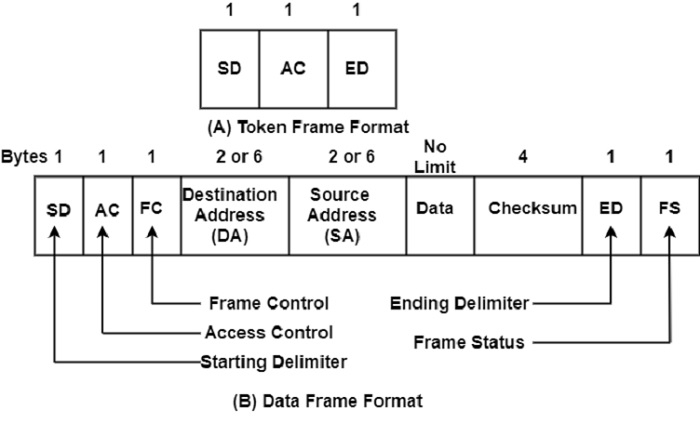
 Data Structure
Data Structure Networking
Networking RDBMS
RDBMS Operating System
Operating System Java
Java MS Excel
MS Excel iOS
iOS HTML
HTML CSS
CSS Android
Android Python
Python C Programming
C Programming C++
C++ C#
C# MongoDB
MongoDB MySQL
MySQL Javascript
Javascript PHP
PHP
- Selected Reading
- UPSC IAS Exams Notes
- Developer's Best Practices
- Questions and Answers
- Effective Resume Writing
- HR Interview Questions
- Computer Glossary
- Who is Who
What are the Token Ring Frame Formats in Computer Network?
There are three types of frame formats that are supported on a Token Ring network such as token, abort, and frame. The token format is the mechanism by which access to the ring is passed from one computer attached to the network to another device connected to the network.
Here, the token format consists of three bytes, of which the starting and ending delimiters are used to indicate the beginning and end of a token frame. The middle byte of a token frame is an access control byte.
Three bits are used as a priority indicator, three bits are used as a reservation indicator, while one bit is used for the token bit, and another bit position functions as the monitor bit.

Components
The components of the Token Ring Frame Format are as follows −
Start Delimiter (SD) − The first field of the data/command frame, SD, is one byte long and is used to alert the receiving station to the arrival of a frame as well as to allow it to synchronize its retrieval timing.
Access Control (AC) − The AC field is one byte long and includes four subfields. The first three bits are the priority field. The fourth bit is called the token bit.
Frame Control (FC) −The FC field is one byte long and contains two fields. The first is a one-bit field used to indicate the type of information contained in the Protocol Data Unit (PDU).
Destination Address (DA) −The two-to-six-byte DA field contains the physical address of the frame’s next destination. If its ultimate destination is another network, the DA is the address of the router to the next LAN on its path.
Source Address (SA) − The SA field is also two to six bytes long and contains the physical address of the sending station. If the ultimate destination of the packet is a station on the same network as the originating station, the SA is that of the originating station.
Data −The sixth field, data, is allotted 4500 bytes and contains the PDU. A token ring frame does not include a PDU length or type field.
Checksum −The checksum field is 4 bytes long. The checksum field is used to cross-check the data at the sending station. This field contains the total number of bytes in the frame. The number is checked at the receiver end after counting the bytes in the received frame.
End Delimiter (ED) −The ED is a second flag field of one byte and indicates the end of the sender’s data and control information.
Frame Status −The last byte of the frame is the FS field. It can be set by the receiver to indicate that the frame has been read or by the monitor to indicate that the frame has already been around the ring.

